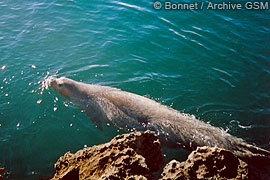

 |
||
 |
||
Vol. 11 (2): November 2008 |
||
Legal protection of the Mediterranean monk seal in CroatiaPetar Radošević, LLMZagreb, Croatia
Although Croatians never commercially exploited monk seals (e.g. for food, skins or oil)1, the animals have since ancient times been blamed for destroying fishermen’s nets, and have been mercilessly killed in revenge by the fishermen. 
With monk seal sightings on the rise in Croatian waters, are protection laws capable of safeguarding the returning species? The present status of this species in the Adriatic is a subject of some discussion among Croatian biologists. The only certain fact is that occasionally monk seals are sighted along the Croatian coast, although these sightings are very rare and some of them (quite) doubtful2. Nevertheless, it is certain that even today Mediterranean monk seals can (if very infrequently) be observed in the Croatian Adriatic. There exist two explanations for these sightings. According to the first, the Mediterranean monk seal in the Adriatic is extinct, and reported sightings are of individual animals that wander into the Adriatic from the Ionian Sea, and afterwards return (assuming they don't perish on the journey). The population of Mediterranean monk seals indigenous to the Adriatic Sea no longer exists3. In contrast, the second theory suggests that there exists, even today, a very small population of Mediterranean monk seals of no more than 20 individuals, that still inhabits the Croatian Adriatic4. The reports of the sightings are of those individuals indigenous to the Croatian Adriatic. While it is not the aim of this article to debate the merits of either theory or to delve deeper into the status of the monk seal in Croatia, it is clear that legal protection of the species within the Republic of Croatia is of importance to the survival of the species and its possible recovery. This is despite the fact that – with no survivors or only intermittent sightings, legal protection remains largely hypothetical. Though its effectiveness may be open to debate, Croatian law contains several provisions to provide for the protection of Monachus monachus. In fact, the species was legally protected for the first time in 1935 by the decree of the Directorate for Maritime Affaires in Split, and it has remained protected under Croatian law ever since5. Unfortunately, this did not prevent its disappearance and possible extinction in Croatia. 
While direct killing by fishermen was largely responsible for the eradication of the species in Croatia, law enforcement rarely met the obligations required of it. The main contemporary legal act that provides for the protection of the Mediterranean monk seal in Croatia is the 2006 ‘Ordinance on declaration of some wild species protected and strictly protected’6, that declares this animal a ‘strictly protected species’. This legal status of monk seals is protected by the ‘Ordinance on damages caused by an illegal act against protected animal species’7. Under this legal statute, a person convicted of killing a Mediterranean monk seal may be fined up to 100.000 HRK (ca. 14.000 EUR). It has to be noted, though, that since there were no reported Mediterranean monk seal killings in Croatia during the last few decades, these legal provisions have never actually been exercised before Croatian courts of justice. Still, we have to note that in case such an act would occur, the foreseen fine would obviously seem unsatisfactory, bearing in mind the critically-endangered status of the seal throughout the Mediterranean, and especially in Croatia (assuming that such a remnant population does survive). Fortunately, the Criminal Code of the Republic of Croatia would consider the killing of a Mediterranean monk seal to be a felony, punishable according to article 259 (its title is ‘Illegal fishing’, but it is applied to all marine animals, not just fish) of the said Code by a prison sentence of up to 1 year. Bearing in mind that the fine for killing of a monk seal was established in 1996, and that its relative value has since significantly diminished (due both to the rise of salaries and of prices in Croatia), it is clear that this should be augmented in the near future, so it would more accurately reflect the severity of the crime. This would be especially necessary in case the sightings of monk seals in the Croatian Adriatic were to become more frequent (as seems to be the case over the last few years), or if the existence of a small monk seal colony in the Adriatic happens to be confirmed.
|
Copyright © 2008 Petar Radošević, The Monachus Guardian. All Rights Reserved |